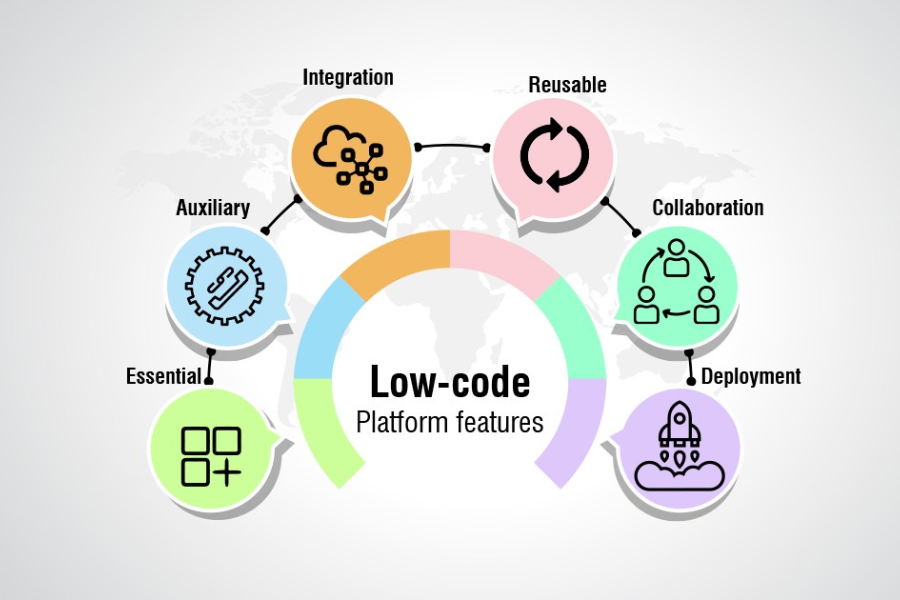Today, businesses are racing to digitalize their workflows, leading to increased spending on technology and software development. However, relying too much on tech companies can delay development timelines. That’s why more businesses are looking for tools to help them digitalize processes, save costs, and reduce dependency on development partners.
So, how can businesses quickly build and deploy software applications on their own? The answer is using Low-Code Platforms.
This article will help you easily compare and choose a suitable low-code platform to support your business’s development and digital transformation.
How Do Low-Code Platforms Optimize the Software Development Process?
Low-code platforms are transformative tools that significantly reduce the workload in the application development process. By providing pre-designed templates with intuitive interfaces, code snippets, and highly compatible development tools, these platforms empower individuals and organizations to create applications without needing to use complex code. Often, it’s as simple as dragging and dropping.

6 Key Factors for Choosing the Right Low-Code Platform for Your Business
1. Supports Creating The Variety of Applications That Meet Your Requirement
Explore the flexibility of low-code platforms. Learn how to create internal business applications, customer portals, and core systems, focusing on scalability, branding, multi-channel support, and simple and effective application deployment.
Key Factors
1.1 Compatibility with Diverse Applications: Check if the low-code platform is suitable for both internal applications and customer-facing applications. Specifically, it needs to provide essential features like user role management, customer portal templates, and customizable interfaces.

1.2 Scalability: Assess the platform’s ability to handle a high number of users and concurrent access without performance issues.
1.3 Brand Customization Capability: Ensure that the low-code platform can adjust brand-related elements such as UI/UX to match the company’s branding standards, providing a consistent user experience.
1.4 Efficient Application Deployment: Consider whether the platform supports simple deployment to app stores or if it requires reliance on a wrapper application. Prioritize creating native applications for seamless user interaction.
1.5 Multi-Channel Capability: Ensure the platform can support multi-channel experiences, extending across the web, mobile devices, and emerging channels like chatbots and voice user interfaces.
2. Licensing Clarity and Predictability
These low-code platforms help you better understand licensing models, developer licensing requirements, and cost simulations to ensure budget and expense management.
Key Factors
2.1 Clear Pricing: Choose platforms that offer transparent pricing, clearly detailing what is included and how it works, avoiding unexpected module-based licenses.
2.2 Developer Licensing: Check if developers need specific licenses to use the platform.
2.3 Cost Simulation: Ensure the platform provides tools to simulate costs based on your business application and the number of users, allowing for accurate budgeting.
3. Control and Governance
Low-code platforms provide the control and governance needed for effective management. Discover how these platforms facilitate collaboration between IT and business teams, while enabling security control and flexible change management.
Key Factors
3.1 Citizen Developer Governance: Look for governance mechanisms that support intuitive communication and collaboration between IT and business stakeholders to reduce risks from citizen developers or externally managed projects.
3.2 Security Control: Assess if the platform allows for easy setup of governance and security measures.
3.3 Change Management: Check the platform’s ability to handle and deploy change requests efficiently, which is vital for flexible development and updates.
4. DevOps Integration

These low-code platforms streamline development processes by integrating DevOps. Explore their support for CI/CD, AI enhancements, flexibility, and adherence to open standards for efficient software delivery.
Key Factors
4.1 CI/CD Support: Ensure the platform offers robust CI/CD capabilities to manage the development process effectively.
4.2 AI Enhancements: Understand the extent of AI integration within the platform to improve the development lifecycle.
4.3 Integration Flexibility: Check if the platform supports integration with various SDLC tools and adheres to open standards for seamless DevOps integration.
5. Developer Productivity and Platform Engineering
Evaluate the reusability, consistency, scalability, and community support of platform components to accelerate development.
Key Factors
5.1 Reusability: Assess the percentage of reusable components in the platform’s catalog to speed up development.
5.2 Component Consistency: Determine if changes or bug fixes to a component are automatically reflected in all solutions using that component.
5.3 Scalability: Confirm if your team can extend default components with their preferred tools and whether there is a supportive developer community.
5.4 Component Deployment: The platform should ensure that all application components are deployed accurately and consistently.
6. Security and Quality of Service
Prioritize security and quality in your low-code journey. Explore real-time monitoring, code scanning, technical debt management, compliance, and code quality assurance.
Key Factors
6.1 Monitoring and Analytics: Confirm real-time monitoring and analytics capabilities to proactively detect and resolve issues.
6.2 Code Scanning: Check for integrated code scanning tools to identify vulnerabilities in your application’s code.
6.3 Technical Debt Management: Evaluate tools to measure and address technical debt in your application.
6.4 Compliance: Verify compliance with industry standards and regulations for both the platform and the provider.
6.5 Code Quality Assurance: Understand how the platform maintains code quality through automated testing and quality assurance processes.
It’s Time to Choose the Right Platform for Your Business
Consider the factors above and selecting a suitable low-code platform will help your organization achieve its goals. To surpass competitors, businesses need to establish a unique brand in their industry, and choosing the right platform can help you accomplish that.
Start developing applications for your company using our made-in-Japan low-code platform, Pleasanter. With its intuitive interface, this platform allows you to build custom applications and deploy them on the cloud or on-premise. Pleasanter’s unlimited capabilities will help you automate workflows, accelerate Rapid Application Development (RAD), and visualize data across various industries such as manufacturing, e-commerce, retail, and more.
Schedule a meeting with our technology experts today to begin exploring!
Reference: Bharat Patel


